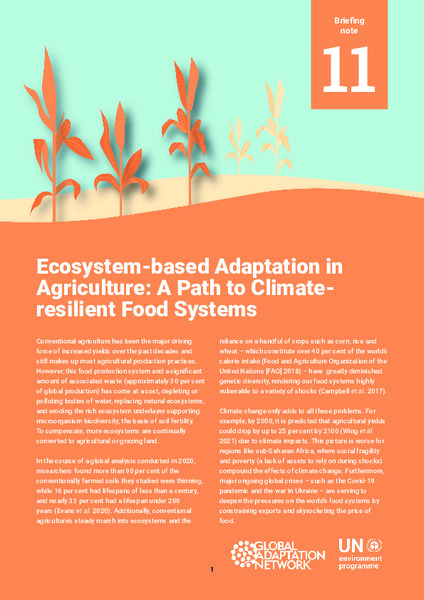| dc.contributor | Ecosystems Division | en_US |
| dc.contributor.author | United Nations Environment Programme | en_US |
| dc.coverage.spatial | Global | en_US |
| dc.date.accessioned | 2022-07-26T08:16:47Z | |
| dc.date.available | 2022-07-26T08:16:47Z | |
| dc.date.issued | 2022-07 | |
| dc.identifier.uri | https://wedocs.unep.org/20.500.11822/40405 | |
| dc.description | Conventional agriculture has been the major driving force of increased yields over the past decades and still makes up most agricultural production practices. However, this food production system and a significant amount of associated waste (approximately 30 percent of global production, according to FAO no date) has come at a cost, depleting or polluting bodies of water, replacing natural ecosystems, and eroding the rich ecosystem underlayer supporting microorganism biodiversity, the basis of soil fertility. To compensate, more ecosystems are continually converted to agricultural or grazing land. | en_US |
| dc.format | Text | en_US |
| dc.language | English | en_US |
| dc.language | French | |
| dc.language | Spanish | |
| dc.language | Portuguese | |
| dc.rights | Public | en_US |
| dc.subject | ecosystem | en_US |
| dc.title | Ecosystem-based Adaptation in Agriculture - Briefing Note 11 | en_US |
| dc.title.alternative | L’adaptation fondée sur les écosystèmes dans l’agriculture :
vers des systèmes alimentaires résilients aux changements
climatiques - Note de synthèse 11 | |
| dc.title.alternative | Adaptación basada en los ecosistemas en agricultura: hacia sistemas alimentarios resilientes al clima - Nota informativa 11 | |
| dc.title.alternative | Adaptação baseada em ecossistemas na agricultura: um caminho para sistemas alimentares resilientes ao clima - Nota Informativa 11 | |
| wd.identifier.sdg | SDG 13 - Climate Action | en_US |
| wd.topics | Climate Action | en_US |
| wd.identifier.pagesnumber | 11 pages | en_US |





